Malaga was recently named one of this year’s top 3 emerging tourist destinations by Tripadvisor’s “Travellers’ Choice Awards”, and it’s not a surprise.
Being a city in constant evolution, it offers so many things to do and see that it could be hard to decide where to start. But don’t worry: we’re here to help! If you want to make sure not to miss any of the most famous and indispensable hotspots in town, have a look at our selection of the best tourist attractions waiting for you in the new Spanish capital of art, culture and food.
Warning: there’s a high risk you will want to come back!
1. The Cathedral
Built over a former mosque, the Cathedral of Malaga is affectionately called by locals “la manquita”, which means “the one armed lady”: look at it from the Plaza del Obispo and you will probably understand why. Although the original plans for this Gothic- Baroque basilica contemplated two towers, the lack of fund resulted in the completion of only one of them.
This gave life to a considerable debate on finishing it in recent years, but the malagueños seem to love it like this, as the absence of one tower is what makes it different and unique.
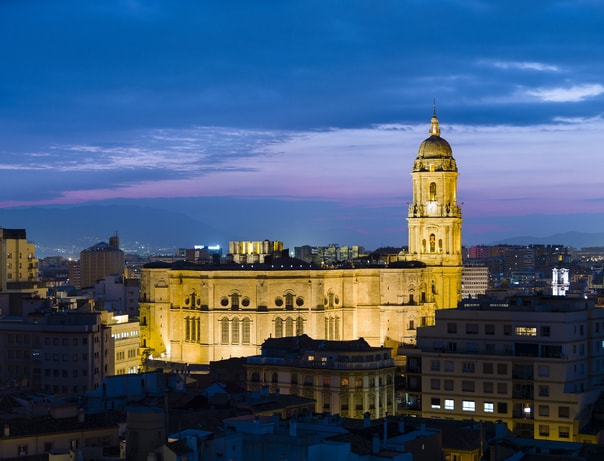
©Área de Turismo. Ayuntamiento de Málaga
Pro tip: in 2015 they opened the cathedral’s roofs for visitors. You will have to climb two hundreds stairs to get there, but the effort is worth it, since you will enjoy a wonderful view!
2. Alcazaba and Roman Theatre
The Alcazaba is one of the two Moorish fortresses of Malaga and it’s known for being the best preserved one in the whole Spanish territory. It dates back to the eighth century, when the first Emir of Cordoba built it with defense purposes against pirates and it’s now the perfect place to go, if you want to take a fascinating journey through time.
You can have a walk through its amazing patios and gardens, and stop to have a look at the city skyline from a privileged point of view.
The entrance is near the Roman Theatre in Calle Alcazabilla, which is the oldest monument in town (it was built in the first century BC) and it’s still used for musical or theatre performances during summer. Our recommendation is to visit both of them on the same day, to have a glimpse at the impressive history of Malaga.

©Área de Turismo. Ayuntamiento de Málaga
3. Gibralfaro
Just in case you haven’t had enough with the Alcazaba, here you have another Moorish fortress to enjoy. The Gibralfaro is a 10th century Arabian castle overlooking the town and, although it has less to offer than the Alcazaba from a strictly historical and architectural point of view, you will definitely love it for its amazing view of the city and port: enjoy it while having a drink or a good meal on the terrace. You can get there by taxi or even walking from the city center, but only if you are brave enough (the road is uphill!)
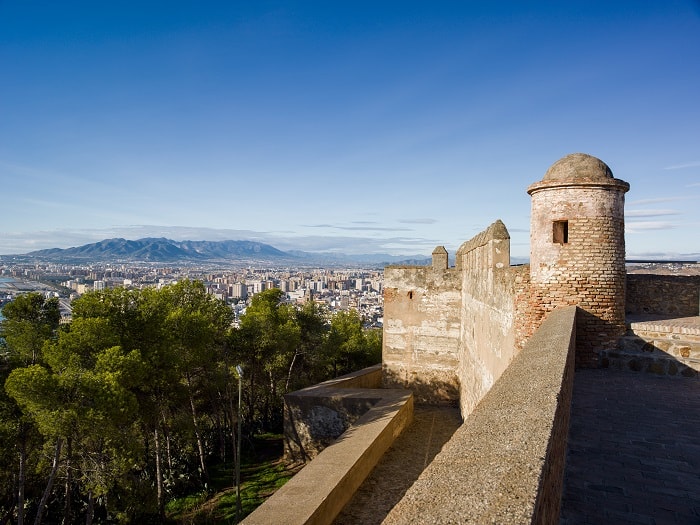
©Área de Turismo. Ayuntamiento de Málaga
4. Muelle Uno
Probably the trendiest place in town. Muelle Uno is a new area that has been completely redeveloped over the last five years to rapidly become one of the favorite places for both tourists and locals.
If you travel by sea, it will probably be the very first thing you’ll see, since the cruise ships stop there. A row of stylish shops and restaurants (among them we can find the Michelin- starred Jose Carlos García) is bounded by two different, but equally iconic landmarks: the Pompidou Center on one side and the “farola” on the other.
Being the only extra-France branch of the prestigious museum, the Centre Pompidou is located in a colorful glass cube and it has been the center of the recent artistic renaissance of the city. Many prestigious newspapers and magazines from all over the world talked about it in their articles and the rise of a new type of tourism encouraged the institutions to open even more museums.
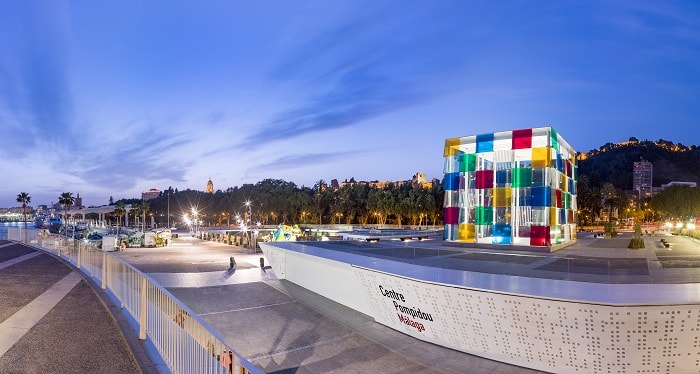
©Área de Turismo. Ayuntamiento de Málaga
On the other side, the “farola” is one of the very few lighthouses in Spain that are named with a feminine desinence: they say it’s because, while inaugurating it in the XIX century, the mayor’s wife said it looked as if it wore a skirt.
Pro Tip: When in Muelle Uno, stop at Artsenal: a brand new cultural space in town where you can enjoy many different art exhibitions, musical performances, intercultural events, a book-crossing library and many places to relax.
5. Pedregalejo
If you love beaches, get ready to have a lot of fun in the capital of the Costa del Sol! While the Malagueta is the most famous and centric one, and the beaches of Huelin and La Misericordia the most recommended ones for those who love sports, El Palo and Pedregalejo are also an authentic heaven for food lovers.
Locals use to go there on Sundays to enjoy a Paella at one of the many restaurants and chiringuitos along the coast, but most of all, to eat one of the most typical dishes: the so called espeto de sardina. They are barbecued sardine skewers that are cooked on small boats on the beach and you should definitely give them a try!

6. Jardín Botánico La Concepción
This Botanical Garden is a true natural paradise of 250,000 square meters that was created around 1855 by two important families of Malaga. Being a Monument of Cultural Interest, it features an incredible collection of tropical and subtropical outdoor flora, with species from Europe, Asia, Oceania, Africa and America.
In the 19th century it was also a meeting point for illustrious personalities, since politicians, artists and the local nobility used to go there quite often. This made the construction of some of the buildings and architectural elements possible that complete the area, like the Palace-House, the house of the Cyprus trees, the greenhouses and the Loringian Museum.
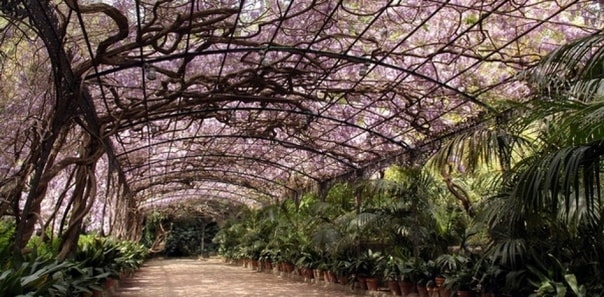
© Área de Turismo. Ayuntamiento de Málaga
Pro tip: once you’re in the Botanical Garden, don’t miss the San Telmo aqueduct. Built in 1782, it was more than 10 km long and it’s considered the most important hydraulic work of the 18th century in Spain!
7. Picasso’s Birth House and Foundation
Malaga is worldwide famous for being the birthplace of Picasso, the most prolific of all professional contemporary painters according to the Guinness World Records. His legacy is still alive in the city and especially in the Plaza de la Merced, where he was born.
The building is an official heritage site since 1983 and a 360 degree tribute to the life and art of Picasso, as well as the headquarters of the Picasso Foundation. There we can appreciate some interesting artworks, as well as objects or personal mementos of his family.
And if you want to know more, on the third floor the Research Centre also offers an amazing archive of material on the artist and his work.
Take a look at our Malaga Tourist Map to see the main attractions and useful information
8. Paseo del Parque
When walking through the Paseo del Parque you will probably forget that you’re in the middle of a capital city: it’s a kilometer-long promenade that goes from the Plaza de la Marina to the district of the Malagueta with palm trees, parrots, small fascinating gardens, fountains and azulejos that provide one of the greenest areas of the city.
Considered one of the most important public parks in Europe, this Mediterranean garden includes subtropical species and it’s the perfect place to have a walk or to relax under the shadow of the trees during the hot, sunny afternoons.
Once you’re there, you might also like to visit the Gardens of Pedro Luis Alonso, next to the Town Hall, where you will find more than 70 different types of roses! Still not enough? Then keep on walking till the “Jardines de Puerta Oscura”, just a few meters away, and enjoy jacarandas among many other botanical species.
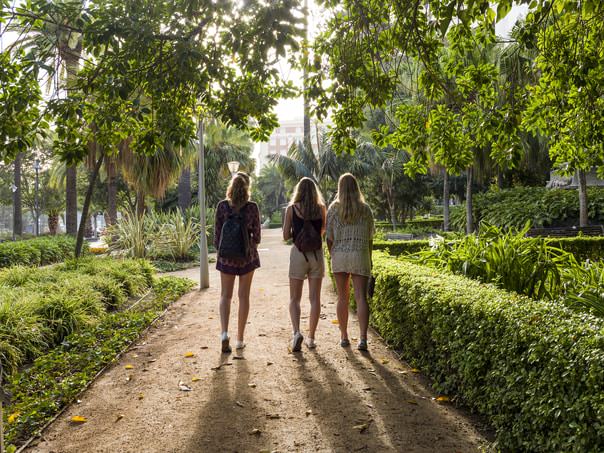
© Área de Turismo. Ayuntamiento de Málaga
9. Museums
Did you know that Malaga is one of the cities with the highest number of museums in Europe? There are more than 30 right now, hosting impressive collections that range from cars to wine, doll houses, music, and of course art! We already mentioned the Centre Pompidou, that is considered the main symbol of this new cultural tourism the city is supporting, but there are definitely many more, well worth a visit.
One of them is the Picasso Museum, which is located in the wonderful Palacio de Buenavista (two minutes away from the cathedral) and it’s probably the most visited museum in town. In its 12 permanent exhibition halls you can enjoy some of the classic Picasso works, together with less known sketches and ceramics and really interesting temporary exhibitions.
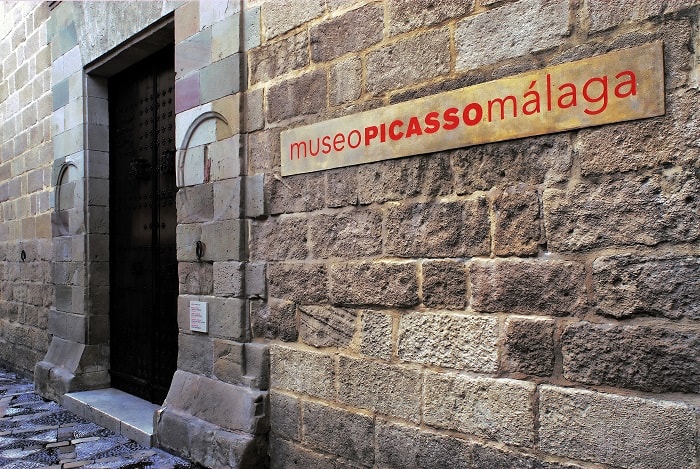
© Área de Turismo. Ayuntamiento de Málaga
If you prefer international art, in the historical building of the old tobacco factory (Tabacalera) you will find the first branch of the Russian Museum of St Petersburg opened outside its country of origin, where 100 artworks dating from the 15th to the 20th century show the art and cultural history of Russia and two different temporary exhibitions are organized every year.
You can easily get there from the city center by bus (take number 16 from the Alameda Principal), by taxi or even by foot, if you don’t mind having a relaxed 30 minutes’ walk.

© Área de Turismo. Ayuntamiento de Málaga
We also recommend you to visit the Contemporary Art Center of Malaga (also known as CacMa), which is considered to be the best one in the entire Andalusian region as it houses exhibitions from very important international artists.
It is the heart of the Soho District: a former residential district that has been rehabilitated during the last few years with the goal to transform it into a real open air graffiti museum.

© Área de Turismo. Ayuntamiento de Málaga
Once you’re done visiting the Art Center, just get lost in its streets to discover prestigious street artworks by important names such as Boamistura, Pantone, Obey, D’Face or Okuda. The best part is that they are continuously popping up, so you’ll have a good reason to come back over and over again!
Finally, you don’t want to miss the new Museum of Malaga that has been recently re-opened in the historical building of the Palacio de Aduana after a 10 year renovation. Here you will be able to enjoy a huge art collection of 2,700 items, including some amazing paintings by Zurbarán and Murillo.

© La Opinión de Málaga
10. Mercado de Atarazanas
There are 15 different food markets in the city, but the Atarazanas Food Market is the biggest and oldest one, being part of the Spanish Heritage Register as a monument of cultural interest: definitely a must-go place for any food lover!Here you will be able to taste the most authentic Malaga flavors and the freshest seasonal products from all over the region. All of it in a building that is an architectural and historical treasure itself.
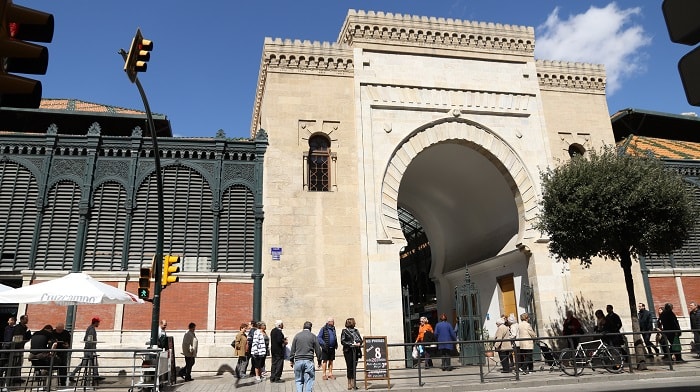
The name “Atarazanas” means “boat arsenal” in Arabic and this is because in the Nasrid epoch, when the Mediterranean Sea reached up untill its doors, it served as a naval workshop. The central marble entrance dates back to that era, while the iron-cast architecture was added later in 1868 by the architect Joaquín de Rucoba, who was inspired by the famous Les Halles market in Paris.
In 2008-10 they renovated the market and included the amazing stained glasses representing the most symbolic monuments of the city that are now one of the most photographed part of the building.
Get ready to satisfy both your eyes and your palate in three different “departments”: meat, fruit/vegetable and fish. The amazing people from the family-owned businesses behind each stall will help you getting lost in a world of different flavors and sensations.
Pro tip: if you want to go there well prepared, check out our complete guide to the Atarazanas food market , and join our Taste of Malaga Tapas Tour to enjoy a 3,5 h. walking food and history tour.
Don’t forget to share this post!
Related Articles
↓
Sign up for our Newsletter and get the inside scoop on our favorite recipes,
exploring and devouring Spain and more.


